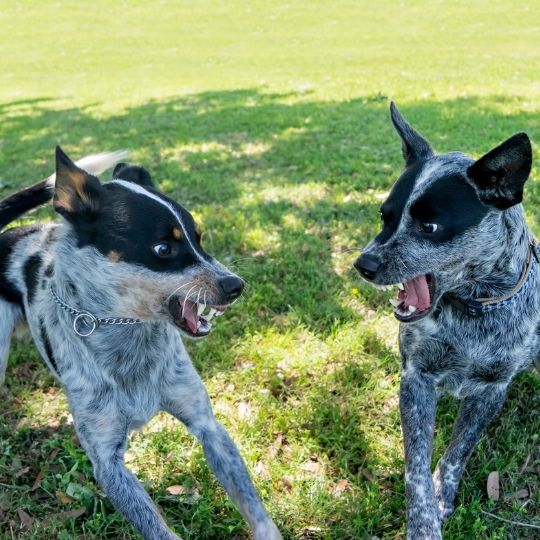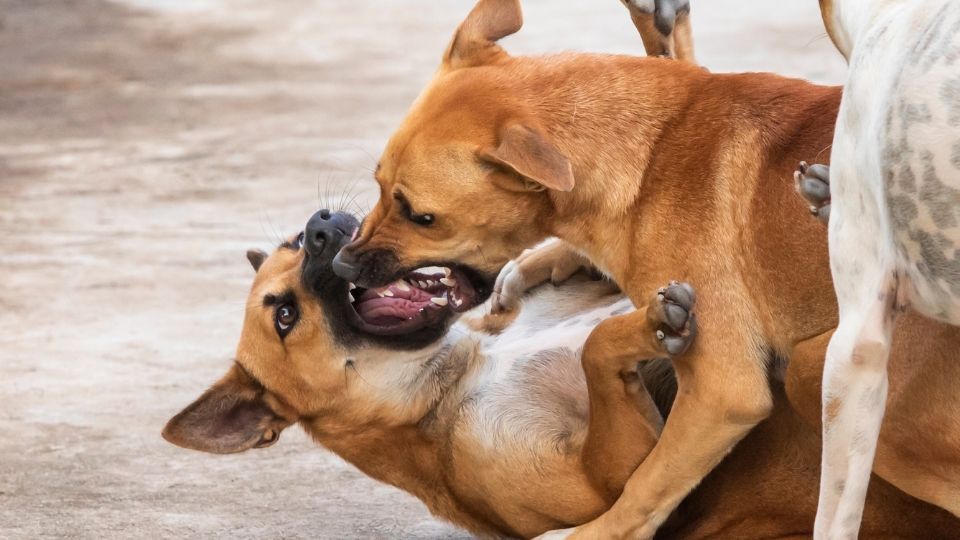How to Break up a Fight Between Two Dogs? Fights Between Dogs: Origin and How to avoid them
Dogs are social animals whose evolutionary history makes them willing and able to live in groups, and group coexistence sometimes leads to dog fights.
Living in a group allowed the ancestors of the dog, the wolves, to work together to feed themselves, take care of their young and defend their territory.
It is common for a dog to interact with another dog at some point.
However, at this time, one or both dogs may seek contact for a fight, light or intense.
Many adopters have experienced this violent situation, so it is essential to know how to act at this time.
Why do Dogs Fight?
Dogs are animals that can fight for many different reasons, as they are often involved in fights where their canine instincts are natural.
Knowing the main reasons why two dogs fight will help you know how to intervene appropriately.
Fight for territory
This conflict is more common between male dogs and occurs for territoriality reasons, so although the situation seems serious, it may not be.
Protection fight
Dogs are protective animals; therefore, they will always protect their bowl, their adopter or the whole family.
To protect them, they can attack any individual or dog.
Go from game to fight.
In dogs, there is an overstimulation that can turn a simple, friendly game into a fight.
Dogs that live together
Dogs that live together may not get along well and start fights anytime.
When dogs are frustrated at being unable to get what they want, they may direct that annoyance at their furry best friend.
Dogs don’t always have to get along.
Doesn’t get along with other dogs
On many occasions, there will be the presence of an aggressive dog who dislikes another dog’s personality, smell, and even presence.
Dogs that “visit” other dogs in the home
If a dog has never had other dogs in their home, it is recommended that the dogs meet on neutral ground first, even if the host dog has a good character.
Walk near another dog.
It is necessary to avoid too close encounters between two dogs as a precaution.
It is better to change the sidewalk if you feel the slightest tension.
How to Break up a Fight Between Two Dogs?

When adopters sense that their animal is in danger, it is customary to try to help avoid it, as in the case of a fight with another dog.
However, the utmost caution should be taken.
As adopters, we could be hurt by any dog due to their survival instincts when we try to defend our pets.
You need to be aware of the complications and repercussions of trying to separate or protect your dog without any necessary preparation or knowledge.
Therefore, to avoid injuries, there are techniques or strategies to achieve this.
Regardless of the training or confidence we have in our dog. Avoiding or entering instinctively in the middle of the fight is recommended.
Our dog could injure it by accident.
There are different techniques, tricks or strategies designed for this situation, not only to interrupt or stop a dog fight safely but to do so in a short time to prevent the dog from being seriously hurt or injured.
Techniques for intervening in a fight between dogs
This may seem like a self-explanatory recommendation, but it is essential.
Most people, when they see a dog attacking their dog, and a dogfight breaks out, they are either scared or not doing their best.
You have to think with a cool head and strategically to analyze what is happening correctly.
Similarly, you must ask the other people present to calm down to avoid aggravating the situation.
- Clear the combat zone:
Most dog fights occur in public or crowded places like a beach, squares, parks, streets or even in the house’s hallway.
It is, therefore, expected that other people are on site.
It is essential to ask people to move away and give them more space because they can hurt themselves, especially if there are children.
Also, remove objects that can break or injure dogs.
- Face spray technique:
The spray technique is one of the most recommended ways to stop dog fights.
This technique consists of sprinkling water on the face and eyes of the two dogs. This technique is effective for different combat levels, both light and severe and intense fights.
Of the possibilities for spraying a dog, the easiest is with a hose directly into the dog’s eyes and nose.
Thus, both will try to change direction to avoid discomfort.
If you don’t have a hose, you can spray it with a bucket or any bottle.
Another recommended technique is to use noises to distract dogs.
It could be a car horn or any other noise that might catch your attention.
This technique only works with light or low-intensity fights.
It is recommended not to use this technique with shouting, as it affects the dogs instead of helping them.
It may even backfire and encourage the dogs to keep fighting.
Items can be used strategically to break up and stop combat.
It can be a blanket or an umbrella, but nothing that can hurt them.
What you want to achieve by using the object is to try to limit the dog’s vision of the other and make contact between the two impossible.
This will calm them down and stop the fight.
- Trolley technique:
If you meet another person, you can use the wheelbarrow technique.
They stand behind each dog and simultaneously pull on its hind legs.
This wheelbarrow technique must be performed quickly and simultaneously to break up the fight successfully.
- Have sprays for future fights:
A good recommendation to be prepared for a possible fight in the future is to have sprays, for example, lemongrass spray.
Citronella spray has better characteristics than other sprays. This spray does not injure or cause damage to dogs’ eyes and mucous membranes.
These sprays help break up dog fights because dogs dislike and are uncomfortable with their smell.
It works as a perfect distraction.
How to Break up a Fight Between Two Dogs?
Prevention is always the best cure.
Dogfights can happen, but if they can be avoided, they suit everyone.
- Socialization and education in time:
As puppies, it is essential to ensure that the dog socializes.
Not just with other people but with children and with other dogs and animals.
From an early age, you can get the right dog temperament.
The dog must learn the basic commands such as standing still, sitting down and responding to the call of its adopter.
Undoubtedly, the orders are necessary to avoid a fight or other uncomfortable or dangerous situations.
As adopters, we must engage in the education of our dog, always with patience and perseverance.
Of course, without any abuse and always with positive reinforcement.
To note: At the slightest sign of aggression in the dog, it is essential to act and, if necessary, to seek help to solve the problem quickly and in the best way.
- Leash and muzzle walks:
A responsible adopter walks his dog always on a leash.
On the other hand, if the dog is not very sociable, a muzzle is recommended.
We are responsible for preventing our dog from starting or getting into a fight.
It is also essential to avoid any aggression toward people.
- Take a walk at different times:
To avoid fights, removing the dog from the world is not necessary. Quite the contrary.
The dog needs to release energy so as not to aggravate the situation.
One recommendation is to take him for walks at times when he is not with other dogs or people.
Avoiding stimuli that can cause an aggressive event will help keep the dog calm, and at the same time, everyone can enjoy the walk.
Male dogs fight the vast majority of the time for territoriality due to their sizeable hormonal component.
To reduce this behavior, castration is recommended before the dog’s first year of life.
If it’s done later, it won’t be as effective.
- Reading dog body language:
A dog’s body language is not as quickly read as you think.
A panting dog may appear smiling but may be fearful, nervous, and ready to bite if threatened.
Being aware of these behaviors will undoubtedly prevent many potential fights.
How to recognize a possible fight in dogs?
The dog can adopt certain behaviors that will help us identify a possible fight.
The dog can:
- be intimidated
- Lick your lips.
- Excessive yawning.
- stay away
- Make them flatten their ears.
- Curled and erect tail.
- Keep your head turned, but face the perceived threat.
If any of these signs or behaviors are observed in the dog, it is essential to remove them from the area quickly to avoid a possible fight.
What not to do when dogs fight?
If a dog starts to fight with another, it is normal for the adopter to be worried, but this reaction can negatively impact the resolution of the fight.
He must not:
- Using violence against dogs and yelling hysterically:
In this way, you are simply contributing to the fight.
Dogs that feel pain associate it with the opponent, increasing their nervousness.
- Put your hands in the middle.
Even if it’s your dog, it can bite you.
The dog is driven by the adrenaline of the moment and will only see its opponent.
Your hand trying to pull them apart would be an obstacle he has to clear to achieve the goal.
Both adopters must work together to resolve the situation before the dogs are hurt or injured.
Ignoring can only make dogs fight longer and get hurt.
- Reward the dog when it attacks another dog:
If a dog has just tried to attack another and the fight has been avoided, do not comfort or reward it.
In canine language, aggressive behavior is rewarded.
Conclusion
It is necessary to observe the behaviors of a dog.
Paying attention to the signs they offer will help your adopter learn to anticipate attacks from other dogs.
If you have a dog at home and you think it is not very nice, it is best to contact a specialist who can help you with your animal.
A veterinarian can determine when a dog is aggressive, when help is needed and why supervised care from adopters is needed.
Do not hesitate to seek their help if necessary, and do not exclude the support of a canine ethologist.
Have you ever had a fight in which your dog was the attacker or was attacked?
Share your experience with us!
